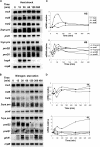A comprehensive analysis of the peroxiredoxin reduction system in the Cyanobacterium Synechocystis sp. strain PCC 6803 reveals that all five peroxiredoxins are thioredoxin dependent
- PMID: 19820102
- PMCID: PMC2786602
- DOI: 10.1128/JB.00831-09
A comprehensive analysis of the peroxiredoxin reduction system in the Cyanobacterium Synechocystis sp. strain PCC 6803 reveals that all five peroxiredoxins are thioredoxin dependent
Abstract
Cyanobacteria perform oxygenic photosynthesis, which gives rise to the continuous production of reactive oxygen species, such as superoxide anion radicals and hydrogen peroxide, particularly under unfavorable growth conditions. Peroxiredoxins, which are present in both chloroplasts and cyanobacteria, constitute a class of thiol-dependent peroxidases capable of reducing hydrogen peroxide as well as alkyl hydroperoxides. Chloroplast peroxiredoxins have been studied extensively and have been found to use a variety of endogenous electron donors, such as thioredoxins, glutaredoxins, or cyclophilin, to sustain their activities. To date, however, the endogenous reduction systems for cyanobacterial peroxiredoxins have not been systematically studied. We have expressed and purified all five Synechocystis sp. strain PCC 6803 peroxiredoxins, which belong to the classes 1-Cys Prx, 2-Cys Prx, type II Prx (PrxII), and Prx Q, and we have examined their capacities to interact with and receive electrons from the m-, x-, and y-type thioredoxins from the same organism, which are called TrxA, TrxB, and TrxQ, respectively. Assays for peroxidase activity demonstrated that all five enzymes could use thioredoxins as electron donors, whereas glutathione and Synechocystis sp. strain PCC 6803 glutaredoxins were inefficient. The highest catalytic efficiency was obtained for the couple consisting of PrxII and TrxQ thioredoxin. Studies of transcript levels for the peroxiredoxins and thioredoxins under different stress conditions highlighted the similarity between the PrxII and TrxQ thioredoxin expression patterns.
Figures







Similar articles
-
Comparative analysis of cyanobacterial and plant peroxiredoxins and their electron donors: peroxidase activity and susceptibility to overoxidation.Methods Enzymol. 2013;527:257-73. doi: 10.1016/B978-0-12-405882-8.00014-3. Methods Enzymol. 2013. PMID: 23830636
-
Photosynthetic regulation of the cyanobacterium Synechocystis sp. PCC 6803 thioredoxin system and functional analysis of TrxB (Trx x) and TrxQ (Trx y) thioredoxins.Mol Plant. 2009 Mar;2(2):270-83. doi: 10.1093/mp/ssn070. Epub 2008 Nov 17. Mol Plant. 2009. PMID: 19825613
-
Overoxidation of 2-Cys peroxiredoxin in prokaryotes: cyanobacterial 2-Cys peroxiredoxins sensitive to oxidative stress.J Biol Chem. 2010 Nov 5;285(45):34485-92. doi: 10.1074/jbc.M110.160465. Epub 2010 Aug 24. J Biol Chem. 2010. PMID: 20736168 Free PMC article.
-
Peroxiredoxins in plants and cyanobacteria.Antioxid Redox Signal. 2011 Aug 15;15(4):1129-59. doi: 10.1089/ars.2010.3657. Epub 2011 May 4. Antioxid Redox Signal. 2011. PMID: 21194355 Free PMC article. Review.
-
The function of peroxiredoxins in plant organelle redox metabolism.J Exp Bot. 2006;57(8):1697-709. doi: 10.1093/jxb/erj160. Epub 2006 Apr 10. J Exp Bot. 2006. PMID: 16606633 Review.
Cited by
-
NADPH-Thioredoxin Reductase C Mediates the Response to Oxidative Stress and Thermotolerance in the Cyanobacterium Anabaena sp. PCC7120.Front Microbiol. 2016 Aug 18;7:1283. doi: 10.3389/fmicb.2016.01283. eCollection 2016. Front Microbiol. 2016. PMID: 27588019 Free PMC article.
-
Thioredoxin-like2/2-Cys peroxiredoxin redox cascade supports oxidative thiol modulation in chloroplasts.Proc Natl Acad Sci U S A. 2018 Aug 28;115(35):E8296-E8304. doi: 10.1073/pnas.1808284115. Epub 2018 Aug 13. Proc Natl Acad Sci U S A. 2018. PMID: 30104347 Free PMC article.
-
Depletion of m-type thioredoxin impairs photosynthesis, carbon fixation, and oxidative stress in cyanobacteria.Plant Physiol. 2021 Nov 3;187(3):1325-1340. doi: 10.1093/plphys/kiab321. Plant Physiol. 2021. PMID: 34618018 Free PMC article.
-
Unraveling the redox properties of the global regulator FurA from Anabaena sp. PCC 7120: disulfide reductase activity based on its CXXC motifs.Antioxid Redox Signal. 2014 Mar 20;20(9):1396-406. doi: 10.1089/ars.2013.5376. Epub 2014 Jan 2. Antioxid Redox Signal. 2014. PMID: 24093463 Free PMC article.
-
Characterization of TrxC, an Atypical Thioredoxin Exclusively Present in Cyanobacteria.Antioxidants (Basel). 2018 Nov 13;7(11):164. doi: 10.3390/antiox7110164. Antioxidants (Basel). 2018. PMID: 30428557 Free PMC article.
References
-
- Apel, K., and H. Hirt. 2004. Reactive oxygen species: metabolism, oxidative stress, and signal transduction. Annu. Rev. Plant Biol. 55:373-399. - PubMed
-
- Baier, M., and K. J. Dietz. 1997. The plant 2-Cys peroxiredoxin BAS1 is a nuclear-encoded chloroplast protein: its expressional regulation, phylogenetic origin, and implications for its specific physiological function in plants. Plant J. 12:179-190. - PubMed
-
- Bernroitner, M., M. Zamocky, P. G. Furtmuller, G. A. Peschek, and C. Obinger. 2009. Occurrence, phylogeny, structure, and function of catalases and peroxidases in cyanobacteria. J. Exp. Bot. 60:423-440. - PubMed
Publication types
MeSH terms
Substances
LinkOut - more resources
Full Text Sources
Molecular Biology Databases
Research Materials

